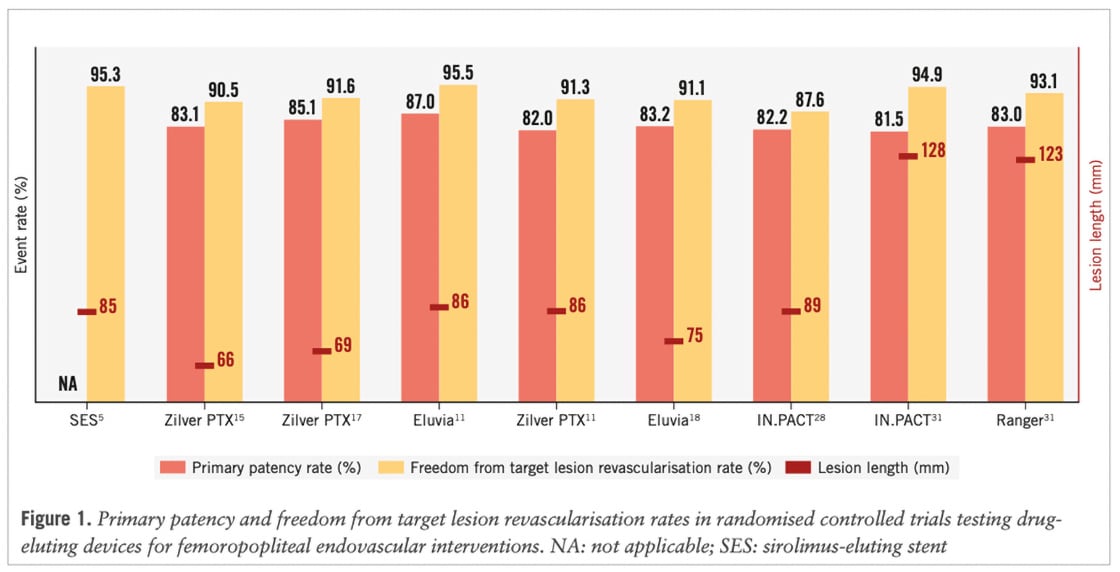Drug-eluting devices for lower limb peripheral arterial disease: a focus on safety and efficacy
Peripheral arterial disease (PAD) is a significant cause of cardiovascular morbidity, particularly affecting patients with femoropopliteal and below-the-knee (BTK) arterial lesions. These patients, often presenting with symptoms ranging from intermittent claudication to chronic limb-threatening ischemia (CLTI), face an elevated risk of limb loss if left untreated.
Over the years, endovascular interventions have become the preferred revascularisation strategy for these patients, with drug-eluting devices playing a critical role.
Why this study?
This study provides a thorough review of the current evidence on drug-eluting stents (DES) and drug-coated balloons (DCBs), focusing on their safety and efficacy in treating PAD, especially in complex lesions, where restenosis remains a challenge.
As the use of these devices becomes more widespread, particularly in challenging clinical settings, it is essential to understand their comparative effectiveness and long-term safety.
Key findings:
1 - Efficacy of drug-eluting stents (DES):
- For patients undergoing treatment of femoropopliteal lesions, drug-eluting stents have shown to be highly effective. Notably, the Eluvia DES, which utilises a polymer-based system to deliver paclitaxel, has demonstrated superior results in maintaining vessel patency.
In the EMINENT trial, a 1-year follow-up revealed that the primary patency rate for patients treated with Eluvia was 83.2 %, significantly higher than the 74.3 % observed in those treated with bare metal stents (BMS) (p = 0.0077).
This suggests that, in this patient population, polymer-based DES can offer enhanced outcomes, particularly in preventing restenosis and the need for repeat interventions. - Furthermore, the SPORTS trial provided additional evidence supporting the use of Eluvia DES, showing that it outperforms both BMS and paclitaxel DCBs in terms of freedom from target lesion revascularisation (TLR) over a 12-month period.
2 - Efficacy of drug-coated balloons (DCBs):
- A large body of evidence supports the use of DCBs as an important adjunct during femoropopliteal revascularisation procedures and, at a time now, paclitaxel-coated devices have shown the best efficacy. Indeed, the efficacy of DCBs at the femoropopliteal level was extensively illustrated by numerous trials demonstrating the safety and efficacy of these devices.
- From a revascularisation standpoint, the probably most important technical issue is adequate vessel preparation, either with POBA, or other techniques, such as specialty/scoring balloons. Sirolimus-coated DCBs still need to prove their efficacy.
- The step towards applications in the BTK arteries of DCBs was relatively small, with the idea to offer a potential valid solution for all the aforementioned DES caveats in tibial vessel treatments. Despite the initially promising results deriving from single-centre studies, four multicentre prospective RCT studies failed to prove any clinical superiority of DCB over POBA.
Clinical relevance:
The study's findings have substantial implications for clinical practice. In patients with PAD affecting the femoropopliteal segment, paclitaxel-eluting devices have proven their safety and efficacy in comparison to POBA and bare metal stents for the endovascular treatment of the femoropopliteal segment in reducing the need for further interventions and improving outcomes.
However, for BTK lesions, the decision is more nuanced. Data are still lacking for indications of paclitaxel eluting devices for the endovascular treatment of the below the knee arteries despite different RCTs. Numerous new scaffoldings, drugs are currently assessed to improve the outcomes of lower limbs endovascular treatment, but improvements will be also based on new ways to evaluate the patients, the lesions or to realise the vessel preparation.
Visual insights:

Figure 1 from the study illustrates the comparison of primary patency and freedom from target lesion revascularization (TLR) rates among different drug-eluting devices in femoropopliteal interventions. Source: EuroIntervention
If this article piqued your interest in the original paper, hold off until you’ve watched the videos below! The authors themselves dive into the chapters they contributed to, highlighting the value of this state-of-the-art publication—you won’t want to miss it!
Interested in learning more about peripheral arterial disease (PAD)?
To mark the release of this state-of-the-art review, don't forget that we're offering free access to three additional articles from EuroIntervention Journal!

